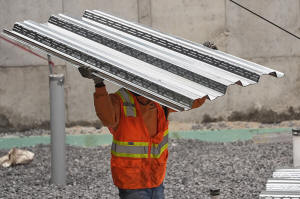US hiring stalls with employers reluctant to expand in an economy grown
increasingly erratic
[September 06, 2025] By
PAUL WISEMAN, ANNE D'INNOCENZIO and CORA LEWIS
WASHINGTON (AP) — The American job market, a pillar of U.S. economic
strength since the pandemic, is crumbling under the weight of President
Donald Trump’s erratic economic policies.
Uncertain about where things are headed, companies have grown
increasingly reluctant to hire, leaving agonized jobseekers unable to
find work and weighing on consumers who account for 70% of all U.S.
economic activity. Their spending has been the engine behind the world’s
biggest economy since the COVID-19 disruptions of 2020.
The Labor Department reported Friday that U.S. employers — companies,
government agencies and nonprofits — added just 22,000 jobs last month,
down from 79,000 in July and well below the 80,000 that economists had
expected.
The unemployment rate ticked up to 4.3% last month, also worse than
expected and the highest since 2021.
“U.S. labor market deterioration intensified in August,'' Scott
Anderson, chief U.S. economist at BMO Capital Market, wrote in a
commentary, noting that hiring was "slumping dangerously close to stall
speed. This raises the risk of a harder landing for consumer spending
and the economy in the months ahead.''
Alexa Mamoulides, 27, was laid off in the spring from a job at a
research publishing company and has been hunting for work ever since.
She uses a spreadsheet to track her progress and said she’s applied for
111 positions and had 14 interviews — but hasn't landed a job yet.
“There have been a lot of ups and downs,” Mamoulides said. “At the
beginning I wasn’t too stressed, but now that September is here, I’ve
been wondering how much longer it will take. It’s validating that the
numbers bear out my experience, but also discouraging.''
The U.S. job market has lost momentum this year, partly because of the
lingering effects of 11 interest rate hikes by the Federal Reserve’s
inflation fighters in 2022 and 2023.
But the hiring slump also reflects Trump’s policies, including his
sweeping and ever-changing tariffs on imports from almost every country
on earth, a crackdown on illegal immigration and purges of the federal
workforce.
Also contributing to the job market's doldrums are an aging population
and the threat that artificial intelligence poses to young, entry-level
workers.
After revisions shaved 21,000 jobs off June and July payrolls, the U.S.
economy is creating fewer than 75,000 jobs a month so far this year,
less than half the 2024 average of 168,000 and not even a quarter of the
400,000 jobs added monthly in the hiring boom of 2021-2023.

When the Labor Department put out a disappointing jobs report a month
ago, an enraged Trump responded by firing the economist in charge of
compiling the numbers and nominating a loyalist to replace her.
“The warning bell that rang in the labor market a month ago just got
louder,’ Olu Sonola, head of U.S economic research at Fitch Rates, wrote
in a commentary. “It’s hard to argue that tariff uncertainty isn’t a key
driver of this weakness.”
Trump's protectionist policies are meant to help American manufacturers.
But factories shed 12,000 workers last month and 38,000 so far this
year. Many manufacturers are hurt, not helped, by Trump's tariffs on
steel, aluminum and other imported raw materials and components.
Construction companies, which rely on immigrant workers vulnerable to
stepped-up ICE raids under Trump, cut 7,000 jobs in August, the third
straight drop. The sweeping tax-and-spending bill that Trump signed into
law July 4 delivered more money for immigration officers, making threats
of a massive deportations more plausible.
The federal government, its workforce targeted by Trump and by
billionaire Elon Musk's Department of Government Efficiency, cut 15,000
jobs last month.
And any job gains made last month were remarkably narrow: Healthcare and
social assistance companies – a category that spans hospital to daycare
centers – added nearly 47,000 jobs in August and now account for 87% of
the private-sector jobs created in 2025.
Nekia McNair, a 49-year-old single mother, has been searching for work
for more than four months without success. “They’re not giving out
jobs,” she said while sitting with neighbors outside her downtown
Indianapolis apartment complex.
Despite 12 years of experience working as home health aide, McNair has
had difficulty even securing an interview. “Then some jobs have you get
dressed, come all the way out there for an interview, and then they’ll
say, ‘Oh well, we got some more people coming and we’ll get back with
you,’ and you’ll never hear from them.”

Democrats were quick to pounce on the report as evidence that Trump’s
policies were damaging the economy and hurting ordinary Americans.
“Americans cannot afford any more of Trump’s disastrous economy. Hiring
is frozen, jobless claims are rising, and the unemployment rate is now
higher than it has been in years,” said Rep. Richard Neal of
Massachusetts, the top Democrat on the House Ways and Means Committee.
“The president is squeezing every wallet as he chases an illegal tariff
agenda that is hiking costs, spooking investment, and stunting domestic
manufacturing.″
[to top of second column] |

A construction worker carries steel decking at the site of a
construction of a housing project, Thursday, July 31, 2025, in
Portland, Maine. (AP Photo/Robert F. Bukaty, File)
 Trump's sweeping import taxes —
tariffs — are taking a toll on businesses that rely on foreign
suppliers.
Trick or Treat Studios in Santa Cruz, California, for instance, gets
50% of its supplies from Mexico, 40% from China and the rest from
Thailand, The company, which makes ghoulish masks that are replicas
of such horror icons as Michael Myers of the "Halloween'' franchise
as well as costumes, props, action figures and games, has seen its
tariff bill rise to $389,000 this year, said co-founder Christopher
Zephro. He was forced to raise prices across the board by 15%.
In May, Zephro had to cut 15 employees, or 25% of his workforce.
That marked the first time he’s had to lay off staff since he
started the company in 2009. ″That’s a lot money that could have
been used to hire more people, bring in more product, develop more
products,” he said. “We had to do layoffs because of tariffs. It was
one of the worst days of my life.”

Josh Hirt, senior economist at the financial services firm Vanguard,
said that the tumbling payroll numbers also reflect a reduced supply
of workers – the consequence of an aging U.S. population and a
reduction in immigration. “We should get more comfortable seeing
numbers below 75,000 and below 50,000’’ new jobs a month, he said.
“The likelihood of seeing negative (jobs) numbers is higher,’’ he
said.
Economists are also beginning to worry that artificial intelligence
is taking jobs that would otherwise have gone young or entry-level
workers. In a report last month, researchers at Stanford University
found "substantial declines in employment for early-career workers''
— ages 22-25 — in fields most exposed to AI. The unemployment rate
for those ages 16 to 24 rose last month to 10.5%, the Labor
Department reported Friday, the highest since April 2021.
Jobseeker Mamoulides is sure that competition from AI is one of the
reasons she's having trouble finding work. “I know at my previous
company, they were really embracing AI and trying to integrate it as
much as they could into people’s workflow,” she said. “They were
getting lots of (Microsoft) ‘Copilot’ licenses for people to use.
From that experience, I do think companies may be relying on AI more
for entry-level roles.”
Some relief may be coming.
The weak August numbers make it all but certain that Federal Reserve
will cut its benchmark interest rate at its next meeting, Sept.
16-17. Under chair Jerome Powell, the Fed has been reluctant to cut
rates until it sees what impact Trump’s import taxes have on
inflation. Lower borrowing costs could — eventually anyway —
encourage consumers and businesses to spend and invest.
Vanguard’s Hirt expects the Fed to reduce its benchmark rate – now a
range of 4.25% to 4.5% – by a full percentage point over the next
year and says it might cut rates at each of its next three meetings.

Trump has repeatedly pressured Powell to lower rates, and has sought
to fire one Fed governor, Lisa Cook, over allegations of mortgage
fraud in what Cook claims is a pretext to gain control over the
central bank. The president blamed Powell again for slowing jobs
numbers Friday in a social media post, saying “Jerome ‘Too Late’
Powell should have lowered rates long ago. As usual, he’s ‘Too
Late!’”
The July 4 budget bill also “included a big wallop of front-loaded
spending on defense and border security, as well as tax cuts that
will quickly flow through to household and business after-tax
incomes,'' Bill Adams, chief economist at Comerica Bank, wrote in a
commentary.
But the damage that has already occurred may be difficult to repair.
James Knightley, an economist at ING, noted that the University of
Michigan's consumer surveys show that 62% of Americans expect
unemployment to rise over the next year. Only 13% expect it to fall.
Only four times in the last 50 years has their employment outlook
been so bleak
“People see and feel changes in the jobs market before they show up
in the official data – they know if their company has a hiring
freeze or the odd person here or there is being laid off,” Knightley
wrote. "This suggests the real threat of outright falls in
employment later this year.''
___
AP Writer Josh Boak in Washington and video journalist Obed Lamy in
Indianapolis contributed to this story.
All contents © copyright 2025 Associated Press. All rights reserved
 |